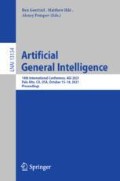Abstract
We start by discussing the link between ecosystem simulators and artificial general intelligence (AGI). Then we present the open-source ecosystem simulator Ecotwin, which is based on the game engine Unity and operates on ecosystems containing inanimate objects like mountains and lakes, as well as organisms, such as animals and plants. Animal cognition is modeled by integrating three separate networks: (i) a reflex network for hard-wired reflexes; (ii) a happiness network that maps sensory data such as oxygen, water, energy, and smells, to a scalar happiness value; and (iii) a policy network for selecting actions. The policy network is trained with reinforcement learning (RL), where the reward signal is defined as the happiness difference from one time step to the next. All organisms are capable of either sexual or asexual reproduction, and they die if they run out of critical resources. We report results from three studies with Ecotwin, in which natural phenomena emerge in the models without being hardwired. First, we study a terrestrial ecosystem with wolves, deer, and grass, in which a Lotka-Volterra style population dynamics emerges. Second, we study a marine ecosystem with phytoplankton, copepods, and krill, in which a diel vertical migration behavior emerges. Third, we study an ecosystem involving lethal dangers, in which certain agents that combine RL with reflexes outperform pure RL agents.
Access this chapter
Tax calculation will be finalised at checkout
Purchases are for personal use only
References
Darwin, C.: On the Origin of Species by Means of Natural Selection (1859). The complete work of Charles Darwin online. http://darwinonline.org.uk/
Nieuwenhuys, R.: The insular cortex: a review. In: Hofman, M.A., Falk, D. (eds.) Evolution of the Primate Brain, vol. 195 of Progress in Brain Research, pp. 123–163. Elsevier (2012)
Stein, R.B., Capaday, C.: The modulation of human reflexes during functional motor tasks. Trends Neurosci. 11(7), 328–332 (1988)
Niv, Y.: Reinforcement learning in the brain. J. Math. Psychol. 53(3), 139–154 (2009)
Neftci, E.O., Averbeck, B.B.: Reinforcement learning in artificial and biological systems. Nat. Mach. Intell. 1(3), 133–143 (2019)
Xu, C.S., et al.: A connectome of the adult drosophila central brain. BioRxiv (2020)
Keramati, M., Gutkin, B.: A reinforcement learning theory for homeostatic regulation. In: Advances in Neural Information Processing Systems, pp. 82–90 (2011)
Yoshida, N.: Homeostatic agent for general environment. J. Artif. Gen. Intell. 8(1), 1–22 (2017)
Badia, A.P., et al.: Agent57: outperforming the Atari human benchmark. In: International Conference on Machine Learning, pp. 507–517. PMLR (2020)
Lanham, M.: Learn Unity ML-Agents-Fundamentals of Unity Machine Learning: Incorporate New Powerful ML Algorithms Such as Deep Reinforcement Learning for Games. Packt Publishing Ltd. (2018)
Sunehag, P., et al.: Reinforcement learning agents acquire flocking and symbiotic behaviour in simulated ecosystems. In: Artificial Life Conference Proceedings, pp. 103–110. MIT Press (2019)
Yamada, J., Shawe-Taylor, J., Fountas, Z.: Evolution of a complex predator-prey ecosystem on large-scale multi-agent deep reinforcement learning. In: 2020 International Joint Conference on Neural Networks (IJCNN), pp. 1–8. IEEE (2020)
Lotka, A.J.: Elements of Physical Biology. Williams & Wilkins (1925)
Christensen, V., Walters, C.J.: Ecopath with Ecosim: methods, capabilities and limitations. Ecol. Model. 172(2–4), 109–139 (2004)
Zador, A.M.: A critique of pure learning and what artificial neural networks can learn from animal brains. Nat. Commun. 10(1), 1–7 (2019)
Kotseruba, I., Tsotsos, J.K.: 40 years of cognitive architectures: core cognitive abilities and practical applications. Artif. Intell. Rev. 53(1), 17–94 (2020)
Wilson, S.W.: The Animat path to AI. MIT Press (1991). Is part of: From Animals to Animats: Proceedings of the First International Conference on Simulation of Adaptive Behavior (J. A. Meyer and S. W. Wilson, eds.), pp. 15–21
Schulman, J., Wolski, F., Dhariwal, P., Radford, A., Klimov, O.: Proximal policy optimization algorithms. arXiv preprint arXiv:1707.06347 (2017)
Karlsson, T.: Multi-agent deep reinforcement learning in a three-species predator-prey ecosystem. Master’s thesis, Chalmers (2021)
Seuront, L.: Copepods: Diversity, Habitat and Behavior. Nova Science Publishers (2014)
Ferrari, P., Kleve, B.: A generic model of motivation in artificial animals based on reinforcement learning. Master’s thesis, Chalmers (2021)
Glimmerfors, H., Skoglund, V.: Combining reflexes and reinforcement learning in evolving ecosystems for artifical animals. Master’s thesis, Chalmers (2021)
Author information
Authors and Affiliations
Corresponding author
Editor information
Editors and Affiliations
Rights and permissions
Copyright information
© 2022 Springer Nature Switzerland AG
About this paper
Cite this paper
Strannegård, C. et al. (2022). The Ecosystem Path to AGI. In: Goertzel, B., Iklé, M., Potapov, A. (eds) Artificial General Intelligence. AGI 2021. Lecture Notes in Computer Science(), vol 13154. Springer, Cham. https://doi.org/10.1007/978-3-030-93758-4_28
Download citation
DOI: https://doi.org/10.1007/978-3-030-93758-4_28
Published:
Publisher Name: Springer, Cham
Print ISBN: 978-3-030-93757-7
Online ISBN: 978-3-030-93758-4
eBook Packages: Computer ScienceComputer Science (R0)

